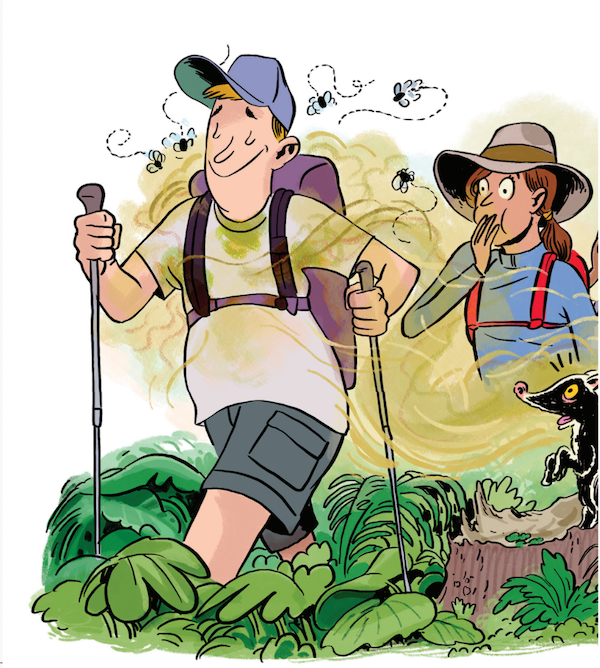Products You May Like
Curiosity is the root of adventure. You let it lead you to the next switchback, the next view, the next trailhead. Likewise, it probably drives you to ask questions—about everything from the color of the sky to why your knees are killing you. We gathered the most burning queries and spent weeks scouring textbooks, deciphering diagrams, and grilling experts for the answers. The result? Dozens of factoids that will impress even your most well-read hiking partner and leave you with a new appreciation for our world. (Here, we answer questions about gear. Check out our deep dives into hiker physiology and nature.)
Why does condensation form in tents?
As you sleep, you exhale warm water vapor. That vapor cools when it touches a chilly tent fly, causing the airborne water molecules to slow down, clump together, and pool into droplets.
Why does sticky shoe rubber stick?
Attraction between the atoms in your shoe and atoms on the ground creates friction. The greater the contact area, the more atoms interact. “Sticky rubber” is just a formulation of rubber that’s so soft, a footstep can squish it into the microscopic textures of the rock in order to vastly increase the contact area—and therefore atomic attraction.
Are women’s sleeping bags really warmer than men’s?
Yup. Most sleeping bags come with an internationally standardized rating called an “EN” or “ISO” rating. This tells
you what temperature range is appropriate, from super cozy (its “comfort” limit), to decently warm (“extreme”). Usually, women sleep colder than men, so women’s bags are labeled with their ISO “comfort” rating while men’s bags list the “extreme” rating, says Sierra Designs product manager Ryan Bertrand. Example: A women’s 20°F bag might have an ISO comfort rating of 20°F and an extreme rating of 14°F, meaning it’ll keep an average male comfortable down to 14°F. That doesn’t mean dudes should buy women’s bags to get more bang for their buck: Ladies’ bags have different proportions than men’s bags.

Why is wool so good at repelling stink?
Bacteria grow best on damp, smooth surfaces. So, you can think of the shiny, sweaty, synthetic fibers in your polyester tee as a perfect petri dish for odor-producing microbes. Wool fibers, on the other hand, are covered with microscopic scales—natural structures that bacteria aren’t as excited to reproduce all over. Plus, wool absorbs and wicks tons of moisture. No external moisture on your skin or clothes = no frisky bacteria.
How do hollow-pore water filters work?
Hollow-pore filters are filled with tiny straws, each made of superfine mesh. These tubes fold in half to form a “V,” which is stuffed into a filter casing and glued in place. Pressure from the filter forces water against the tip of the V at one end of the tube. The pores in the mesh are so small that water molecules can pass into the tubes, but bacteria, sediment, and other floaties can’t. Voila: Clean water pours out the open ends of the tubes on the other side of the filter.
Do trekking poles help my gait or ruin it?
They help reduce the load on lower extremities by up to 16 percent, according to physiologist Ashley Hawke. “We’ve seen consistent research showing that using poles alleviates pain in the knee,” she adds. The only time they might cause trouble? Leaning forward on your poles while hiking downhill on loose terrain, which can throw your balance forward, causing slips and slides.
How does DEET work, and if it can dissolve my rain shell, why isn’t it toxic?
DEET repels insects without hurting them. It’s so effective—and nonlethal—that farmers could spray DEET alongside deadly pesticides to deter honey bees, keeping them safe, says CDC entomologist Jeff Bloomquist. Interestingly enough, scientists still aren’t 100% sure how DEET works. One of the better theories is that DEET targets nerve endings in mosquitoes’ antennae, temporarily blinding them to tasty smells, says Bloomquist.
As for its effect on human health? “After 80 years of using this stuff, there’s little evidence that it’s dangerous,” Bloomquist explains. Yes, high concentrations can degrade gear, but “humans fortunately aren’t made of plastic,” he says.
Why don’t compasses point true north?
Humans use “true north”—a fixed, geographic point at the top of the globe—as a navigational reference. But compass needles don’t actually “point” to the north pole, they simply align with the lines of the earth’s magnetic field, which is created by the flow of liquid nickel and iron around the earth’s core (badass, right?), and influenced by solar winds. That’s why it’s constantly shifting around, usually up to 37 miles in a year. Because “true north” and “magnetic north” come from totally separate mechanisms, they only roughly line up, and the similarity varies at different points on the earth’s surface. Hence, declination.
How long can I keep a down sleeping bag stuffed before it’s ruined?
You can forget about that compression sack for up to a month before it’s a lost cause, says Ryan Bertrand of Sierra Designs. “But please, please don’t push your luck.” What actually keeps you warm in a sleeping bag isn’t the fill—it’s the air trapped within it. Squish those feathers together long enough for them to deform, and you reduce the air space where heat can settle, which lets the cold seep in.
Do high-top boots really provide more ankle stability than low-top shoes?
“In our research, we compared hiking shoes and mid-top boots. We looked at muscle activity, joint forces generated, and physiological variables during uphill walking … and found there were essentially no differences between boots and shoes.” —Ashley Hawke, physiology researcher at Northern Michigan University

Why do fuels work differently in cold weather?
BUTANE
Isobutane and butane have the same ingredients: four carbon atoms and 10 hydrogen atoms. Yet, butane molecules are zig-zag-shaped, so in cold temps, they tend to clump together instead of bouncing around inside the canister. The result: a slow, lazy fuel stream.
ISOBUTANE
Isobutane molecules are a different shape than regular butane. They have a “tail,” which means they can’t get too close to one another. So, the molecules keep moving, creating higher pressure within the fuel canister—and a more even fuel stream in low temps.
PROPANE
Small molecules aren’t as strongly attracted to each other, so tiny molecules in propane bounce around within the canister a lot more than butane. That’s why propane canisters have to be so sturdy—and why they stay at high pressure even in the cold.
WHITE GAS
White gas, a cocktail of petroleum-derived fuels, is the most reliable choice in winter conditions. This is because liquid fuel stoves that use white gas let you manually regulate canister pressure, ensuring a consistent, even fuel stream no matter the temperature.
Why does good pack suspension make loads feel lighter?
“Our spines have a bunch of little pads and pivot points. When the weight of your pack rests on your shoulders, these get pinned and compressed. That reduces upper body mobility and makes loads feel heavy and uncomfortable.
“So, the goal is to pull the load in toward your body and push it down into the hips. A good suspension is strong enough to both resist downward forces from gravity and outward forces from the compression straps, and direct loads straight downward to the pelvis. The result is increased range of motion, which makes you feel unencumbered. Plus, the force is now distributed across your hips, a larger surface area than your shoulders. If you have the same amount of force, but distributed over a greater area, that means fewer pounds of force per square inch (and therefore less pressure) and sensation of weight.” —Dana “D3” Gleason, product manager and pack designer at Mystery Ranch
Why are rain shells less effective over time?
Rain shells have three main parts: An outer fabric, a durable water repellent (DWR) coating, and a waterproof internal membrane. The membrane has many tiny pores that water vapor can pass through but liquid water droplets can’t. Your pit sweat is full of vaporized moisture, which is drawn through the pores of your shell to the drier air outside. But when the durable water repellent coating on your shell gets dirty or oily, it stops working. Water then sticks to your shell fabric, essentially blocking the pores. That makes your membrane impermeable in both directions: Rain is trapped outside—and sweat is trapped inside. The result? You feel damp and clammy, even though your membrane is still perfectly waterproof. To fix the problem, wash your shell with a technical wash detergent.
